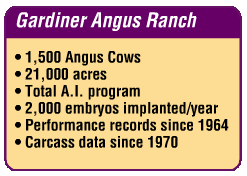
Gardiner Angus Ranch encompasses more than 48,000 acres in southwest Kansas. Each year, GAR breeds more than 1,500 head of females for fall calves. All females, both registered and commercial Angus, are settled by either embryo transfer or artificial insemination within a 60-day breeding season, without the use of clean-up bulls. During calving season at GAR, more than 1,000 baby calves will hit the ground within a 45-day period.
GAR collects and transfers more than 2,000 embryos annually. As a result, better than 60% of registered calves born are from embryo transfer. GAR commercial Angus cows are used as recipients for embryos from registered donors. Embryos are also implanted in recipients from GAR cooperator herds.
The main donor herd is collected for one year, then bred and sold in the Gardiner Angus Ranch annual production sale. A new set of donors are then selected for the following year. The ET donors are selected from the top end of the registered cow herd based on production, pedigree, and EPDs.

Commercial cows that don’t settle by embryo transplant are bred by artificial insemination. GAR selects A.I. sires from the American Angus Association’s Sire Evaluation based on: high accuracies for light birth weight, adequate milk, moderate mature size, a heavy yearling weight, and good carcass EPDs. Since 1964, performance records have been kept on all registered and commercial calves born at Gardiner Angus Ranch. Feedlot and carcass data has been collected on all A.I. sires since 1970.
The commercial cattle represent the same breeding as the registered cattle, and are the descendants of Ralph W. Gardiner’s original commercial Angus females from the early 1930s.
For the last eight years, all breeding has been done at GAR’s breeding center. The 20-acre center consists of three octagonal corrals divided into 36 pie-shaped pens. All pens connect to a major alley leading to the A.I. barn. The facility, designed for maximum efficiency and minimum stress on cattle, has enabled Gardiner Angus to consolidate all feeding, breeding, and heat detection into one location.

Gardiner Angus Ranch conducts its production sale in early April and fall bull sale in September. Since the first sale in 1980, GAR has sold one-fourth of its registered cow herd to continually focus on raising the genetic average of the entire herd, and to sell customers the very best genetics possible. GAR’s spring sale has grown to one of the largest in the U.S. More than 95% of bulls sold in both sales go into commercial herds.